
Solar Eclipse Pictures: 2012 "Ring of Fire" Dazzles U.S., Asia
By Andrew Fazekas, National Geographic News, 21 May 2012.
By Andrew Fazekas, National Geographic News, 21 May 2012.
1. "Smiling" Solar Eclipse
A solar eclipse turns the disk of the sun into a wide orange grin over Gumaca in the Philippines on Monday morning, local time. Although the sun is only minimally covered in this picture, the so-called annular eclipse went on to create a "ring of fire" for sky-watchers in parts of Asia and the U.S. West.
An annular eclipse happens when the moon lines up between Earth and the sun, and when the dark moon's apparent diameter is smaller than the visible disk of the sun, leaving a ring - or annulus - of fiery light around the edges.
Because of the vagaries of time zones, this weekend's "time traveling" solar eclipse started in China on Monday around sunrise, raced across the Pacific Ocean, and made "landfall" again in the United States on Sunday evening.
— With reporting by Andrew Fazekas
2. Chain of Events
A combination of pictures shows the stages of Monday's annular solar eclipse, as seen from Tokyo. During the eclipse, the moon's shadow crossed over Japan around 7:35 a.m. Monday, local time.
For an annular eclipse, "the path of annularity, where the full eclipse will be visible, is hundreds of miles wide and thousands of miles long," said eclipse expert Jay Pasachoff of Williams College in Massachusetts.
In this path "viewers looking through special solar filters can see a ring of sunlight around the black silhouette of the moon," said Pasachoff, who is also a National Geographic Society grantee. (National Geographic News is a division of the Society.)
3. Safety First
Using a telescope with a special filter, a man watches the solar eclipse from Baja California in Mexico on Sunday.
Although Mexico wasn't in the path of the full "ring of fire" eclipse, viewers there could still see a striking partial eclipse. (See partial eclipse pictures.)
"Unlike a total eclipse, in which the sun is entirely covered and the sky therefore gets dark, it never gets dark during an annular eclipse like this one," Pasachoff said.
"So the only loss in view from being off to the side of the zone of totality is that you won't see a complete ring, and things won't appear symmetric."
4. Silvery Ring
The dark moon leaves only a thin circle of silver light from the sun during the annular eclipse, as seen from Utsunomiya, Japan, on Monday.
Japan hasn't seen an annular eclipse since 1839, according to the Associated Press. Japanese TV crews filmed from the top of Mount Fuji, while several groups arranged eclipse tours at schools and parks, on pleasure boats, and even on private airplanes.
In Tokyo the day started with light rain, but the clouds thinned as the sunrise eclipse reached its peak, allowing for prime viewing. (Related: "Solar Eclipses Can [Slightly] Change Weather on Earth.")
"It was a very mysterious sight," Kaori Sasaki told the AP from downtown Tokyo. "I've never seen anything like it."
5. Magic Mountain
The sun is largely obscured by the moon over Mount Shasta, California [USA], in a multiple-exposure picture taken on Sunday. Viewers in North America saw the solar eclipse start at the California-Oregon border around 6:30 p.m. PT on May 20.
The eclipse then crossed southern Nevada, southern Utah, the Grand Canyon in northern Arizona, the lower-left corner of Colorado, and most of New Mexico before ending near Lubbock, Texas [USA], around sunset at 8:36 p.m. CT. (See pictures of a June 2010 total solar eclipse.)
6. Burning Ring of Fire
An eclipsed sun sinks toward the horizon near oil rigs north of Odessa, Texas [USA], on Sunday evening.
Some picturesque wilderness areas - including several U.S. national parks - were in the 190-mile-wide (300-kilometre-wide) path of the full annular eclipse.
For most viewers in the path of annularity, the eclipse lasted for just over four and a half minutes.
7. Sun in Shadow
Hands holding a pair of binoculars cast an unusual shadow - complete with twin views of the solar eclipse - as seen in Sacramento, California, on Sunday.
Looking directly at the sun, even during an eclipse, can damage your eyes. Probably the safest and easiest way to take in a solar eclipse is to use the pinhole projection method, Williams College's Pasachoff said.
"Punch a one-eighth to one-quarter-inch hole in a piece of cardboard and use it to create a projection of the partial or annular phases on a wall a few feet away," he said.
8. Solar Activity
The sun is partially covered by the moon in a picture of the solar eclipse taken from Monument Valley Navajo Tribal Park in Utah [USA] on Sunday. Dark blots on the solar disk are sunspots - magnetically active regions on the sun that are relatively cool and so appear darker.
Sunspots are linked to eruptions of intense electromagnetic radiation called solar flares, which can cause disturbances to radio communications on Earth and also hinder radio astronomers' views of the universe. (Find out more about solar storms in National Geographic magazine.)
Before the eclipse, astronomer Anthony Cook, of the Griffith Observatory in California, had predicted that scientists would make use of the event to study the sun's activity.
"Radio telescopes close to the path of annularity will make observations as the moon passes over sunspots and other sources of radio disturbances on the sun," Cook said.
9. Dark Shadows
A brilliant solar crescent seems to rest on a dark blanket of clouds as seen from Quanzhou, China, on Monday.
According to the AP, several hundred people gathered to watch the eclipse from the Kowloon waterfront on Hong Kong's Victoria Harbour, but heavy clouds obstructed the view.
10. Eyes on the Skies
People on a Tokyo rooftop use special glasses to watch the solar eclipse on Monday morning.
To view a solar eclipse safely, astronomers recommend using either a professionally manufactured solar filter in front of a telescope or camera, or using such eclipse-viewing glasses, which sufficiently reduce the sun's brightness and filter out damaging ultraviolet and infrared radiation.
11. Orange Haze
The eclipsed sun rises through cloud-streaked orange skies in Gumaca in the Philippines on Monday.
Northeast, in the capital city of Manila, eclipse-watchers had nearly perfect viewing conditions, according to the AP.
"It's amazing. We do this for the awe [and] it has not disappointed," astronomical hobbyist Garry Andreassen told the news service from a downtown Manila park, where he'd set up his camera.
"I am awed, literally floored."
Top image: California photographer Phil McGrew captured this image of the moon covering the sun's face from Pyramid Lake, Nevada. The solar eclipse occurred May 20, 2012, and was visible over much of the western U.S. Credit: Phil McGrew. Image source: Live Science.
[See more dazzling images at Live Science.]
Update:
Here's another stunning image of the solar eclipse taken at the Arizona Canyon, USA:
Update:
Here's another stunning image of the solar eclipse taken at the Arizona Canyon, USA:
Imelda Joson and Edwin Aguirre recorded the May 20th annular eclipse of
the Sun in from Page, Arizona, using a
solar-filtered Takahashi FC-60
telescope and a Canon EOS 20D digital SLR camera. Credit: Imelda Joson
and Edwin Aguirre. Source: Our Amazing Planet.
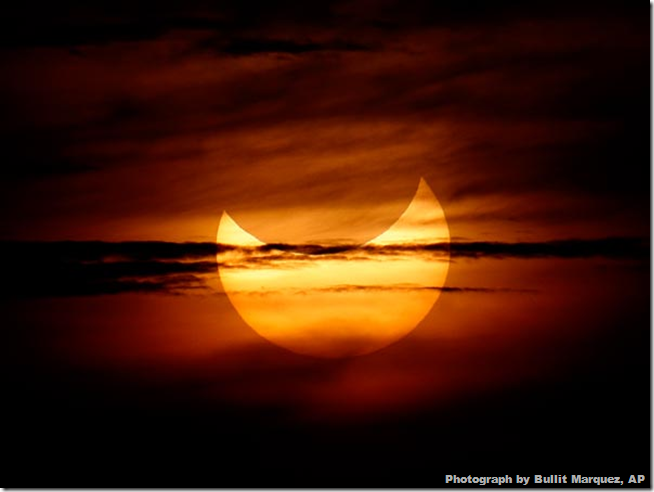
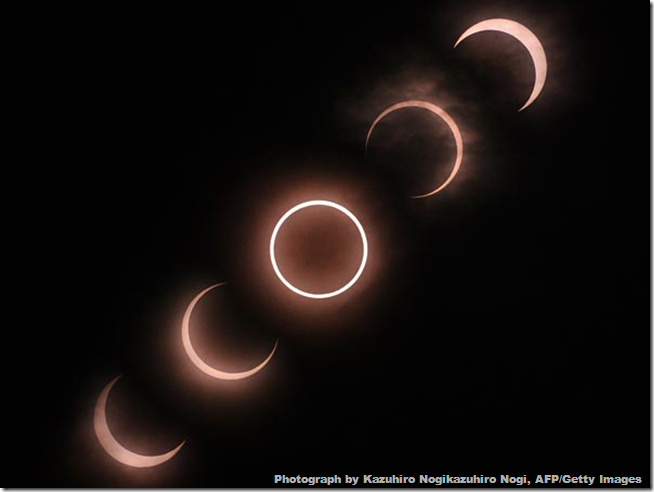

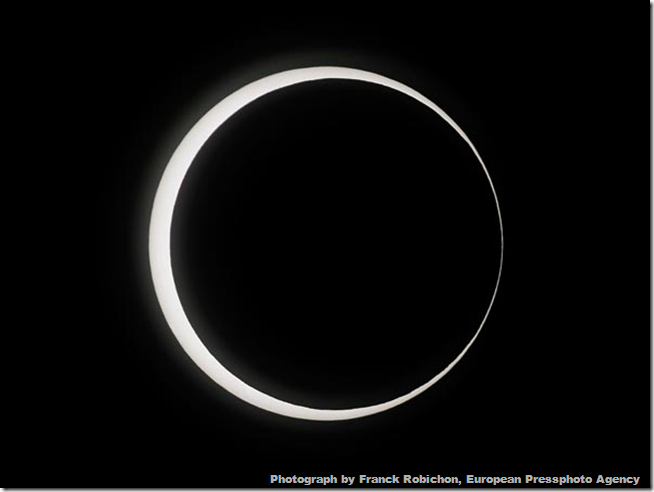
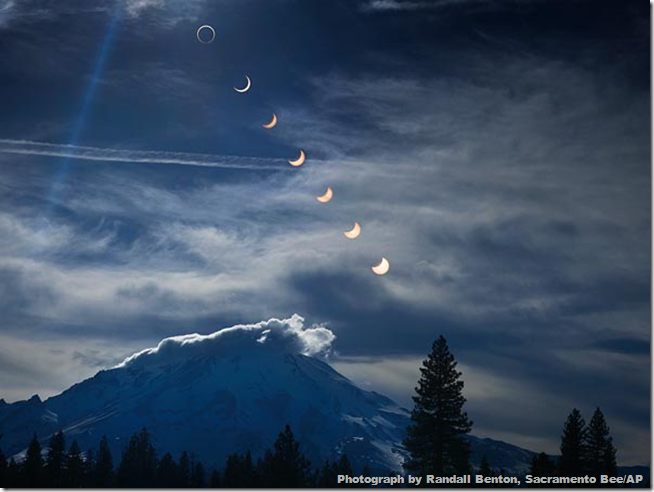

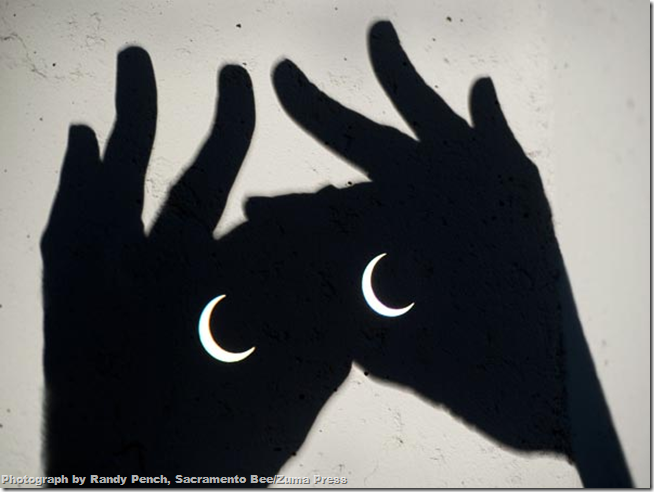


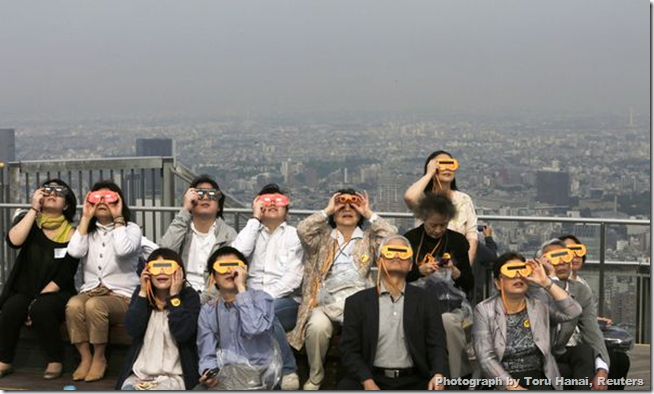


No comments:
Post a Comment
Please adhere to proper blog etiquette when posting your comments. This blog owner will exercise his absolution discretion in allowing or rejecting any comments that are deemed seditious, defamatory, libelous, racist, vulgar, insulting, and other remarks that exhibit similar characteristics. If you insist on using anonymous comments, please write your name or other IDs at the end of your message.